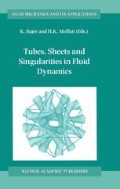Abstract
A magnetically dominated plasma driven by motions on boundaries at which magnetic field lines are anchored is forced to dissipate the work being done upon it, no matter how small the electrical resistivity. Numerical experiments have clarified the mechanisms through which balance between the boundary work and the dissipation in the interior is obtained. Dissipation is achieved through the formation of a hierarchy of electrical current sheets, which appear as a result of the topological interlocking of individual strands of magnetic field. The probability distribution function of the local winding of magnetic field lines is nearly Gaussian, with a width of the order unity. The dissipation is highly irregular in space as well as in time, but the average level of dissipation is well described by a scaling law that is independent of the electrical resistivity.
If the boundary driving is suspended for a period of time the magnetic dissipation rapidly drops to insignificant levels, leaving the magnetic field in a nearly force-free, yet spatially complex state, with significant amounts of free magnetic energy but no dissipating current sheets. Renewed boundary driving leads to a quick return to dissipation levels compatible with the rate of boundary work, with dissipation starting much more rapidly than when starting from idealised initial conditions with a uniform magnetic field.
Application of these concepts to modelling of the solar corona leads to scaling predictions in agreement with scaling laws obtained empirically; the dissipation scales with the inverse square of the loop length, and is proportional to the surface magnetic flux. The ultimate source of the coronal heating is the photospheric velocity field, which causes braiding and reconnection of magnetic field lines in the corona. Realistic, three-dimensional numerical models predict emission measures, coronal structures, and heating rates compatible with observations.
Access this chapter
Tax calculation will be finalised at checkout
Purchases are for personal use only
Preview
Unable to display preview. Download preview PDF.
References
Aschwanden, M. J., Schrijver, C. J. & Alexander, D. 2001 Modeling of Coronal EUV Loops Observed with TRACE. I. Hydrostatic Solutions with Nonuniform Heating. Astrophysical Journal550, 1036–1050.
Fisher, G. H., Longcope, D. W., Metcalf, T. R. & Pevtsov, A. A. 1998 Coronal Heating in Active Regions as a Function of Global Magnetic Variables. Astrophysical Journal508, 885–898.
Galsgaard, K. & Nordlund, Å. 1996a The Heating and Activity of the Solar Corona: I. Boundary Shearing of an Initially Homogeneous Magnetic Field. Journal of Geophysical Research101, 13445–13460.
Galsgaard, K. & Nordlund, Å. 1996b The Heating and Activity of the Solar Corona: II. Kink Instability in a Flux Tube. Journal of Geophysical Research102, 219–230.
Gomez, D. O., Dmitruk, P. A. & Milano, L. J. 2000 Recent theoretical results on coronal heating. Solar Physics195, 299–318.
Gudiksen, B. & Nordlund, Å. 2002 Bulk heating and slender magnetic loops in the solar corona. Astrophys. J. Letters, 572, L113–L116.
Heyvaerts, J. & Priest, E. R. 1992 A self-consistent turbulent model for solar coronal heating ApJ390, 297–308.
Longcope, D. W. & Sudan, R. N. 1994 Evolution and statistics of current sheets in coronal magnetic loops ApJ437, 491–504.
Mikic, Z., Schnack, D. D., & van Hoven, G. 1989 Creation of current filaments in the solar corona ApJ338, 1148–1157.
Nordlund, Å. & Galsgaard, K. 1997 Topologically Forced Reconnection. Lecture Notes in Physicsh489, 179–200.
Parker, E. N. 1972 Topological Dissipation and the Small-Scale Fields in Turbulent Gases. Astrophysical Journal174, 499–510.
Parker, E. N. 1983 Magnetic Neutral Sheets in Evolving Fields. II — Formation of the solar corona. Astrophysical Journal264, 642–647.
Parker, E. N. 1988 Nanoflares and the solar X-ray corona. Astrophysical Journal330, 474–479.
Parker, E. N. 1994 Spontaneous current sheets in magnetic fields: with applications to stellar x-rays. New York: Oxford University Press, 1994.
Porter, L. J. & Klimchuk, J. A. 1995 Soft X-Ray Loops and Coronal Heating. Astrophysical Journal454, 499–511.
Sturrock, P. A. & Uchida, Y. 1981 Coronal heating by stochastic magnetic pumping ApJ246, 331
van Ballegooijen, A. A. 1986 Cascade of magnetic energy as a mechanism of coronal heating ApJ311, 1001–1014.
Author information
Authors and Affiliations
Editor information
Editors and Affiliations
Rights and permissions
Copyright information
© 2002 Kluwer Academic Publishers
About this paper
Cite this paper
Nordlund, Å. (2002). Magnetic dissipation: spatial and temporal structure. In: Bajer, K., Moffatt, H.K. (eds) Tubes, Sheets and Singularities in Fluid Dynamics. Fluid Mechanics and Its Applications, vol 71. Springer, Dordrecht. https://doi.org/10.1007/0-306-48420-X_16
Download citation
DOI: https://doi.org/10.1007/0-306-48420-X_16
Publisher Name: Springer, Dordrecht
Print ISBN: 978-1-4020-0980-8
Online ISBN: 978-0-306-48420-9
eBook Packages: Springer Book Archive

